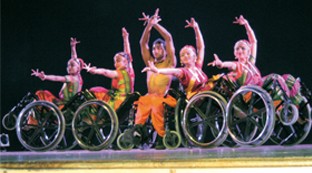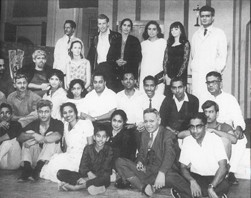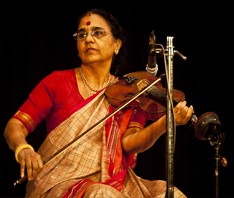COVER STORY - RAVI SHANKAR AT 91 by Shankar Ramachandran
The three-balcony auditorium is filled to capacity. A few extra chairs have been set up in the wings. The accompanists are introduced to polite applause, but the audience jumps to its feet with excitement before the announcer can finish saying Ravi Shankar. The sitar maestro comes on stage with a little assistance, but seems to fill the auditorium with his presence. “I hope you recognise me though I have grown a beard,” he says. And they react with the affection reserved for a longtime friend.
Ravi Shankar takes charge of the proceedings. He sits at the edge of the small dais and makes his own announcements with a hand-held mike before he pick sitar. In the concert, he presents two main raga-s followed by a ragamalika. The percussionists present a tani avartanam with a konnakol recitation.
The concert is sponsored by the Ravi Shankar Foundation and co-sponsored by the Indian Fine Arts Academy of San Diego, whose secretary Dr. Shekar Viswanathan manages the logistics.
NEWS & NOTES - Dance unlimited by S. Janaki

They came, they danced, they conquered – the hearts of the audience. They were young artists with disabilities, but with unlimited abilities. For the first time in Chennai, dancer-teacher Syed Sallaudin Pasha and the members of Ability Unlimited Foundation, Delhi, presented programmes on two consecutive evenings (23 and 24 January) at the Chinmaya Heritage Centre in Chennai. They spun around to Sufi music, danced and struck poses in Bharatanatyam. The confidence, pride, positive energy and the joy of dancing they radiated were infectious and inspiring. The choreography by Guru Pasha was mind blowing, reflecting the tremendous thought, effort and practice put in by the guru and the sishya-s.
The programme on 24 January began with a brief introduction about Sufism by Pasha, followed by Sufi on Wheels depicting the meeting of Jalaluddin Rumi with Shamsuddin Tabrizi. Boys wearing the Sufi headgear, dressed in white gowns covering their wheelchairs moved in slow circles to the soulful strains of Sufiana kalaam. As the music gained momentum, their actions and whirls grew faster and faster. At times they whizzed dangerously close to the edge of the stage, leaving us with our hearts in our mouths, but they moved with split second precision and amazing control in their wheelchairs. Surprisingly, there was a deep meditative quality to their spins and gestures. Pasha announced that what was performed by a handful of dancers was an excerpt from a dance-drama with a cast of 30 artists.
The next item was Yoga Jati which true to its name had jati-s interspersed with difficult yogic stances like the mayurasana and the sirasasana! The wheels assumed life and the wheelchairs seemed to be extensions of the limbs of the dancers. In a lively tillana in Hindolam the boys were joined by girls who were hearing impaired. They too performed on wheelchairs in perfect sync with the boys.
THEATRE - The return of English theatre. Or is it? by Gowri Ramnarayan

Chennai’s claims to the title of cultural capital of India has only meant that it has been the stronghold of Carnatic music and Bharatanatyam. It is a city of sabha-s – private organisations conducting monthly and annual festivals of classical music, dance. The past saw the sabha-s promoting Tamil drama on a large scale – mainly mythological spectacles, “social drama”, and plain farce. English theatre has rarely been part of mainstream Chennai culture.
In the last ten years, English theatre has made its presence felt strongly and insistently, with theatre groups mushrooming everywhere. Old groups have been rejuvenated or have reinvented themselves in new directions.
Not every group has any particular aim beyond the staging of plays, or ideas of developing a character of its own. “Perform or die” could well be the motto of most theatre groups in the city. It is not unusual to see young people trying to patch up and mount a play of sorts, with nothing but enthusiasm to carry them through.
INSTRUMENTS - THE VIOLIN by Deepak S. Raja

There is one musician whom Lord Yehudi Menuhin, the iconic Western violinist, never failed to meet and hear during his trips to India – the violinist, M.S. Gopalakrishnan. Interestingly, Gopalakrishnan commands equal respect in Carnatic and Hindustani music. His musical persona virtually sums up the story of the violin in Hindustani music.
The violin came to India with European colonists – the French in Pondicherry, the Portuguese in Goa, and the British in Bengal. It was introduced to Indian art music by Baluswami Dikshitar (1786-1858), a brother of the legendary Carnatic composer, Muthuswami Dikhsitar. Baluswami heard the violin in a British band, noted its acoustic closeness to the human voice and thought it well suited for accompanying Carnatic vocalism. His father sent Baluswami as well as Muthuswami to study the violin under the bandmaster at Fort William. In 1884, Vadivelu (youngest of the Tanjavur Quartet) and a disciple of the Dikshitar family, introduced the violin to the Travancore court, where it received an enthusiastic response. Around the same time, the Maratha princes of Tanjore also discovered the promise of the instrument, and encouraged its adoption. Since then, several generations of violinists have worked to make the violin a major instrument in Carnatic music.
The instrument entered Hindustani music in the 1930s through the initiatives of Allaudin Khan (Baba), Vishnu Digambar Paluskar, S.N. Ratanjankar, and Gajananrao Joshi.


